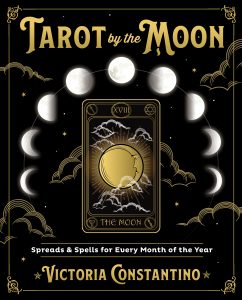
An Excerpt from Tarot by the Moon by Victoria Constantino
Human beings have been attempting to peer beyond the veil for time immemorial. Foretelling one’s future through cards, or cartomancy, is one of many methods of divination. Divination itself is defined as “the art or practice that seeks to foresee or foretell future events or discover hidden knowledge, usually by the interpretation of omens or by the aid of supernatural powers” and alternately, as “unusual insight” and “intuitive perception.” That is the dictionary definition. A further look reveals the word divine implied in the prefix divin-, which comes from the Latin divinus, meaning “of a god”; in the suffix -ation is implied the bringing forth (-ation indicates the product or result of action); therefore, the word, at its essence, means “to bring forth the divine.” Who better than the all-seeing, all-knowing, all-powerful divine to connect with in our asking of what the future may bring?
Whether you use the tarot with the intention of tapping into the divine, connecting with your own divinity, working with guides, angels, and high-vibrational allies, or if your goals are to provide guidance for practical, everyday questions and to further your own self-knowledge and growth, there is something in tarot for everyone.
Appreciators of cartomancy might argue it is one of the most beloved of all divination methods for its incisive pictorial history, which is distilled into archetypal renderings of the human experience. The oldest decks we are currently aware of date from the 15th century, but it’s only in the last few hundred years that it has gained traction in common use. The 21st century has seen a dramatic upsurge in the number of new tarot and oracle decks, coinciding with tarot’s rise in popularity. While the tarot is a type of oracle, which is simply a means of predicting the future, oracle cards are structured differently, as they are typically not beholden to suits and not separated into the Major and Minor Arcana.
Divination itself is classed into four categories—pattern divination, trance divination, omen divination, and symbol divination; tarot finds its place in the latter category. Pattern divination is sometimes defined as a means of producing patterns in an artificial way to determine the outcome of future events, such as reading coffee grounds or interpreting the shapes of wax poured into water. However, the interpretation of patterns does not have to be artificially derived. Gazing at the leaves in a tree or the arrangement of stones on the ground to spot patterns of significance is a natural means of pattern divination. Trance divination infers what is to come through messages received through the physical senses in a trance or dream state. Omen divination is based on the idea that naturally occurring signs, such as a sudden peal of thunder or planetary alignments, have some bearing on what is to come or offer information about the state of things. Symbol divination uses a fixed system to analyze the outcome of a situation or provide information about a specific question. Because the I Ching and tarot are based on fixed symbols, they fall under the umbrella of symbol divination.
Among the many methods of divination are tasseography, or the reading of tea leaves, palm reading or palmistry, the use of runes and pendulums, scrying with water and black mirrors, and numerology, to name but a few. What they all have in common is the use of intuition as an interpretive method. Tapping into the intuition is more art than science, and is rewarded by practice. Like a muscle, the more you put it to use, the stronger it becomes.
That being said, you don’t have to be psychic to be a good tarot reader, or have a direct channel to the divine (although it certainly doesn’t hurt). Of primary importance is the energy with which you approach a reading. In other words, when you are open to receiving the messages that come through, whether in the form of cards, tea leaves, or anything else, you can tap into your chosen method of divination to assess predicted outcomes and deliver a more useful and accurate interpretation.
When we consider, not only our own energy but also the energy of the moon, its documented effects on our planet (and on our lives), and tarot as an energetic conduit, then things get really interesting. Each moon phase has its own energy. The new moon, for instance, is a time of setting intentions and planting seeds for what we want to manifest in the cycle culminating with the full moon, which brings the lunar energy to its peak. In pagan belief systems, the triple goddess is represented in the moon phases: new (maiden), full (mother), and waning (crone). These primal energies correspond with the phases of our lives. Just as we often plant seeds of intention during the new moon and harvest during the full moon, we release and clear energies during the waning moon. You can think of tarot as your energetic companion for every season of your life, just as the moon is always in the sky, in one form or another.
Victoria Constantino is a longtime tarot practitioner and seeker of visionary wisdom. She spent more than a decade as an editor and publisher of literary fiction and nonfiction, and was the managing editor for a prominent women’s lifestyle magazine. She left the field of publishing to focus full-time on her writing and spiritual practice. Her previous publications include poetry and fiction, and instructional guides for a business publisher. She attended the University of Oxford and holds a Master’s degree in writing. She is the author of Tarot by the Moon from Llewellyn.
Visit Victoria's website at victoriaconstantino.com
